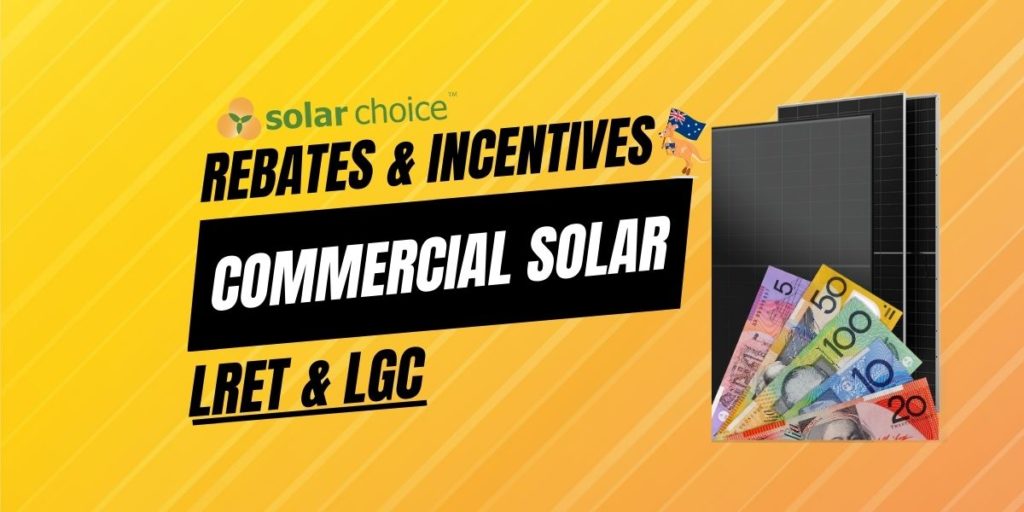Australia’s Large-scale Renewable Energy Target (LRET) and Large-scale Generation Certificates (LGCs) provide substantial financial incentives that act as commercial solar rebates for businesses investing in solar energy. By leveraging these programs, your business can benefit from ongoing revenue through LGCs, making solar power a smart and profitable investment for the long term.
In this guide, we’ll cover:
- What the LRET and LGCs are and how they work.
- How your business can qualify for commercial solar rebates and financial incentives.
- Steps to begin generating LGCs and boosting ROI with commercial solar energy.
Exploring business solar rebates through the LRET offers a pathway to reduce costs, enhance sustainability, and gain lasting financial benefits.
You can view Solar Choice’s complete list of solar rebates in Australia here.
What is the Large-scale Renewable Energy Target (LRET)?
The Large-scale Renewable Energy Target (LRET) is part of Australia’s Renewable Energy Target (RET) scheme and in action act like a commercial solar rebate. It’s a government initiative designed to increase renewable energy generation from sources like solar, wind, and hydro. Through LRET, eligible businesses can receive ongoing financial benefits for their solar power production, helping Australia reduce its carbon footprint and meet energy goals.
Key Facts About the LRET:
- Goal: Generate 33,000 gigawatt-hours of renewable energy per year.
- Eligible Projects: Commercial and utility-scale installations, like large solar farms.
- Incentives: Earn Large-scale Generation Certificates (LGCs) based on energy output.
How Do Large-scale Generation Certificates (LGCs) Work?
Large-scale Generation Certificates (LGCs) are at the core of the LRET program. For every megawatt-hour (MWh) of renewable electricity your business generates, you earn one LGC. These certificates are not only a symbol of your contribution to clean energy but can also be sold for a financial return.
Benefits of LGCs
- Monthly Income Stream: Earn LGCs each month based on actual power production.
- Market Value: Currently around $46.25 per certificate, though prices fluctuate.
- Eligibility Requirements: Systems must be over 100kW in capacity and accredited by the Clean Energy Regulator.
How to Qualify for Commercial Solar Rebates
Step 1: Accreditation
Your solar system must be accredited to participate in the LRET. Systems over 100kW in capacity are eligible, but they must meet specific regulatory standards to generate LGCs.
Step 2: Start Generating Power and Certificates
Once your system is installed and operational, it will begin generating power and, consequently, LGCs each month. The more electricity your system produces, the more certificates you earn.
Step 3: Sell LGCs
LGCs can be sold on the market to utilities and other companies required to meet renewable energy targets. The sale of LGCs provides an ongoing revenue stream for your business, making solar a financially sound investment.
Step 4: Reporting and Compliance
To maintain accreditation, you’ll need to regularly report your power production. This keeps the Clean Energy Regulator informed and ensures your continued eligibility to generate LGCs.
Why Invest in LRET & LGCs for Commercial Solar?
1. Financial Incentives and ROI
The LRET scheme provides a significant ROI for commercial solar installations. By generating LGCs and reducing energy costs, businesses can see substantial financial benefits, making it easier to justify the upfront investment in solar.
2. Environmental Impact and Brand Value
Switching to renewable energy helps businesses reduce their carbon footprints, enhancing their reputation as eco-friendly and socially responsible. With consumers increasingly favoring green brands, participating in the LRET can set your business apart.
3. Energy Independence and Stability
Investing in solar can reduce dependency on fluctuating energy markets, giving your business greater control over energy costs and supply. This independence is particularly valuable during periods of high energy prices.
4. Market Differentiation
Companies that adopt renewable energy can strengthen their brand by showcasing their commitment to sustainability, attracting like-minded customers and investors.
Key Considerations Before Installing Commercial Solar
- System Size: Ensure your system meets the 100kW minimum capacity to generate LGCs and benefit from the LRET.
- Accreditation: Complete the accreditation process through the Clean Energy Regulator.
- Ongoing Management: Plan for regular reporting and system maintenance to continue generating LGCs.
- Market Monitoring: Track LGC prices and market trends to determine the best time to sell for maximum return.
Why LRET is a Smart Choice for Business Solar
The Large-scale Renewable Energy Target (LRET) offers Australian businesses a valuable opportunity to invest in solar energy with ongoing financial incentives. By generating LGCs, businesses can achieve both environmental and economic benefits. For those looking to reduce energy costs and strengthen their sustainability profile, the LRET provides a clear, profitable path to green energy.
Start your journey toward energy independence today by consulting with renewable energy experts and exploring the benefits of the LRET. With the right setup and accreditation, your business can make a lasting impact on both the environment and your bottom line.
Frequently Asked Questions (FAQ) About LRET & LGCs
What is the Large-scale Renewable Energy Target (LRET)?
What is the difference between LRET and SRES?
How much is an LGC worth?
How do Large-scale Generation Certificates (LGCs) work?
How do I know if my system qualifies for LRET benefits?
What are the steps to earn LGCs for my business?
What financial benefits does the LRET offer my business?
How does investing in solar energy help my business stand out?
Do I need to monitor the market for LGC prices?
